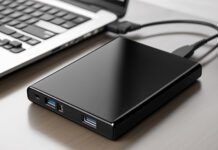Cameras: Sony HDR-CX260V—$400/Camera
One of the most obvious necessities is a few high-quality cameras. You’ll want to make sure the cameras can shoot in at least HD 1080p video, although these days, there are very few consumer-grade camcorders that don’t. You also need to be sure the camera has either an HDMI or SDI output. Depending on where in your sanctuary you plan to place the cameras, you may want to take the camera’s zoom capabilities into consideration. Be sure to purchase a tripod for each camera. You can find lots of options for tripods, at various price points, on Amazon. You can get the super-expensive ones if you want, but really for use in worship, you just need it to be able to hold the camera steady unless you want to get really fancy.
Switchers: Telestream’s Wirecast Studio—$695
When using multiple cameras, you’ll need to have a way to switch between the camera views. There are some cool hardware solutions for this, but they can get pretty pricey. One of my favorite and most cost-effective solutions is the software solution called Telestream’s Wirecast Studio. With Wirecast Studio, you can obviously switch between the cameras, but you can also add in other media, like pre-recorded video, photos, or graphics overlays. It allows you to stream to wherever you’d like while recording to your local computer as well. It’s easy to use and packed full of lots of features.
Audio: TASCAM US-2X2—$150
There are lots of things you can use this audio interface for, but for our purposes, you’re basically using it to get audio from your microphones to your computer. It might be a good idea to use a lavalier microphone with one of the inputs to capture the pastor’s audio, then use a condenser mic in the second input to pick up the room noise and congregation. You’ll want to listen with headphones during the service to make sure the audio is balanced.
Encoder/Capture Card: Blackmagic Design Intensity Shuttle—$200/camera
You’ll use a capture device to get the video feed from your cameras to your computer. The Blackmagic Design Intensity Shuttle makes it so that your computer can accept the HDMI or SDI output from your camera. (The HDMI port on most computers is output-only and will not accept video input.) You will need a capture device like the Intensity Shuttle for each camera you purchase unless you decide to use simple USB webcams. However, it will be hard to see anything from a webcam, especially if you have it set up in the back of the room, as these cameras typically don’t have a very long focal range.
Getting Started on a Larger Budget
While most congregations will likely fall into the smaller-budget category, your church may have some financial resources available, and you may decide to invest in getting an extremely high-quality feed to members who can’t be in worship. If so, there are some really cool solutions out there.
Cameras: Vaddio RoboSHOT 12 QCCU System—$5,000/camera
Get ready for sticker shock! These camera systems are pricey, but man, they’re awesome! The Vaddio RoboSHOT 12 QCCU System is a professional-level camera that comes with a camera control unit (CCU). This unit powers and receives video signals from the camera and allows you to remotely control various camera parameters such as iris, gain, and color temperature. The camera itself is full HD and is able to move all three axes (pan, tilt, and zoom) at the same time.
Camera Controller: Vaddio PCC Premier Precision Controller—$3,200
With professional-level camera systems like the Vaddio RoboSHOT, you can typically purchase a camera controller to be able to have the cameras controlled remotely by one person. The Vaddio PCC Premier Precision Controller integrates perfectly with the Vaddio RoboSHOT 12 QCCU System, allowing you to not only move each camera individually but also set up preset shots to smoothly switch between shots.
I recommend using the same switchers, audio equipment, and encoder/capture card that are listed in the smaller-budget category. While there are more-expensive solutions that may have more bells and whistles, the ones above get the job done at a good price.
Challenges and Advice
Using multiple cameras to record your service is great, but it can be challenging. First of all, it can take a lot of effort and knowledge just to get all your equipment and software working together properly. When you’re livestreaming, you’re also bound to have technical difficulties that pop up every now and then, so being able to troubleshoot what’s wrong under pressure is essential. Depending on your setup, you may also need several volunteers each week to make all of this happen, which can be a stretch for any congregation.
Using multiple cameras in worship can take a lot of work, but for your members who are home-bound, it can mean the world. As you look into moving forward on this task, seek out other churches that have gone before you and learn what has worked and not worked for them. If your budget allows, you may even want to bring in a specialist to help design your setup, that way you can be sure you’re doing the best practices. Be patient as you go and give yourself some grace — videography has a bigger learning curve than you might think.
This article on using multiple cameras originally appeared here.











